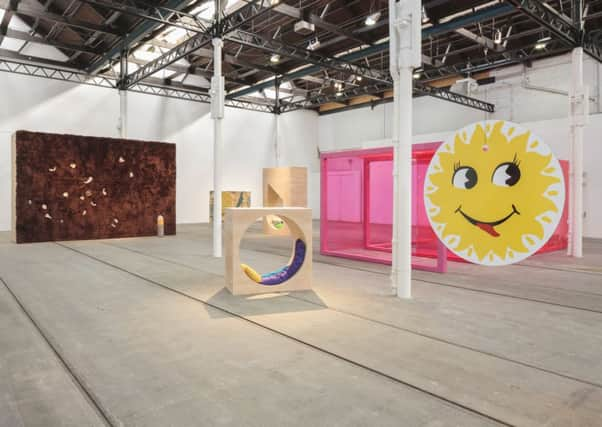Arts review: Laura Aldridge | James Rigler


LAURA ALDRIDGE: CALIFORNIA WOW!
Tramway, Glasgow
***
James Rigler: At Every Fading of the Stars
Tramway, Glasgow
***
There are a lot of holes in Laura Aldridge’s major exhibition at Tramway. That’s not pejorative – she employs them everywhere, from the artful plywood constructions with hollow centres like giant polo mints that are scattered around the place, to the suspended fabric banners that are layered to allow little apertures to open up in the fabric. What looks like a wonky ceramic mural is made of hundreds of ceramic bricks, hand cast by Alistair Dearie and upended to show the core holes that perforate the clay. In Aldridge’s art, objects, meaning and ideas are porous and even people are permeable.
Aldridge graduated from Glasgow’s MFA course in 2006. As part of her studies she spent an exchange year in California at Cal Arts. Here, many years later, in a body of work that still touches on some of the ideas and images that first emerged during her degree show at the same venue, she revisits the sunny optimism of mid-century California design – a groovy, shiny, open aesthetic that preceded the hippy era but helped give rise to it. There’s pink plexi-glass, macramé, shag-pile carpet and rainbow-hued pottery. As she puts it in the exhibition title: California wow!
Advertisement
Hide AdSuspended from the ceiling, are giant metal discs, each painted in enamel with a smiling sunshine face, long-lashed and looking sideways. They are in fact enlarged versions of the in-car air freshener that might dangle from your rear view mirror. The tiny little wall-mounted stars made by artist Bobby Niven that mimic the prickles on a California cactus are actually crafted from rusty nails. From a pink pavilion, like a little modernist house, that the artist has placed in the centre of the gallery, you might imagine you could look out on a landscape of pool-side palms and distant scrub. Instead the only desert you glimpse is one of upended thick shag-pile carpet.
Interiority and exteriority are a recurring theme in Aldridge’s work. Her lovely 2012 show at CCA, Underside, Backside, Inside, Even consisted of giant fabric pockets suspended from the walls like hammocks, with the implication you might just be able to crawl inside them. A recent work in a group show at Glasgow’s Gallery of Modern Art was a clever little narrative on the navel orange, a botanical curiosity in which a tiny orange is buried within the parent fruit.
If those shows were thematically tight, then the challenge with California Wow! is how the artist might sustain those investigations over such a large space. Much of Aldridge’s interest is in the actual process of making: how does it feel to squidge clay between your fingers? To feel the rope between your hands as you make macramé? One of the ways she tries this is through proxies: a series of large scale photographs show figures engaging in actions such as holding, striking, blowing and tearing. The curator and ceramic artist Katy West blows hopelessly on what looks like a broom handle, the designer Laura Spring carries brightly coloured cut-outs. Amongst them is the artist herself in an improvised mask, recognisable more by her hands than her face or physique.
A table top installation is dedicated to the experimental feel of the Seventies through an image of the mother of one of her collaborators, the curator Louise Shelley, surrounded by sculpture as a student and by references to the work of artist Mary Kelley, whose conceptual art works brought themes like childbirth into the field of fine art activity during this period. Scattered on the table are cards and images, little clay figures, questions about what it might mean to make a thing or perhaps a person. Indeed, buried in this show (like the tiny offspring hidden in those naval oranges) are ideas of alternative histories of art, the mother-daughter relationship just one of the ripostes to the traditional father-son genealogy and boys club bonhomie of much modern art.
Aldridge is an exciting artist, excitable even. You get a sense of the rush of thoughts, of the real engagement with things and ideas, of an artist who isn’t afraid of messy words like craft or intuition. It does though feel like timescales or budgets have meant that Aldridge is operating in an arena where she has been overstretched rather than working comfortably at full stretch. Nevertheless there is much to admire about her and about this show.
Next door, one of Aldridge’s collaborators, the ceramic artist James Rigler, has a succinct solo show that is a pastel-clad Jackie Kennedy to Aldridge’s tie-dye California girl. Rigler has a background in both architecture and architectural ceramics and working knowledge of some of the finest interiors in the country: he has, for example, made work for Petworth and spent much of 2013 as artist in residence at the V&A. He’s a man who knows his Doric column from his ionic order. But his pale grey, peach and pink environment, entitled At Every Fading of the Stars, has a shiny, manufactured quality that cleverly suggests it might also be ordered from Ikea.
Advertisement
Hide AdRigler recasts the industrial aesthetic of Tramway as an immaculate post-modern fantasy that uses clay like plastic and plastic like plaster. The functional metal supporting pillars in the gallery have sprouted foliate tops that turn them into Corinthian capitals, a litterbin is a delight of sprouting acanthus. MDF benches sport velvet bolsters and ceramic lion’s paw feet: woodchip meets Chippendale. The result is not just a triumph of kitsch, but a knowing, and somehow melancholy delight. Rigler is a brilliant maker, but he subsumes the need to show that his ceramics are handmade in order to make a wider point about how we manufacture the world around us.
• Laura Aldridge until 22 March; James Rigler until 8 March
FOLLOW US
SCOTSMAN TABLET AND MOBILE APPS